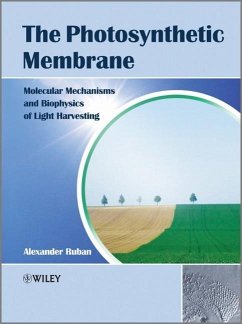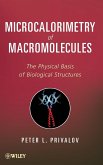Alexander V. Ruban
The Photosynthetic Membrane
Molecular Mechanisms and Biophysics of Light Harvesting
Alexander V. Ruban
The Photosynthetic Membrane
Molecular Mechanisms and Biophysics of Light Harvesting
- Broschiertes Buch
- Merkliste
- Auf die Merkliste
- Bewerten Bewerten
- Teilen
- Produkt teilen
- Produkterinnerung
- Produkterinnerung
The proteins that gather light for plant photosynthesis are embedded within cell membranes in a site called the thylakoid membrane (or the "photosynthetic membrane"). These proteins form the light harvesting antenna that feeds with energy a number of vital photosynthetic processes such as water oxidation and oxygen evolution, the pumping of protons across the thylakoid membranes coupled with the electron transport chain of the photosystems and cytochrome b6f complex, and ATP synthesis by ATP synthase utilizing the generated proton gradient.
The Photosynthetic Membrane: Molecular Mechanisms…mehr
Andere Kunden interessierten sich auch für
![Fluorescent Analogs of Biomolecular Building Blocks Fluorescent Analogs of Biomolecular Building Blocks]() Marcus WilhelmssonFluorescent Analogs of Biomolecular Building Blocks198,99 €
Marcus WilhelmssonFluorescent Analogs of Biomolecular Building Blocks198,99 €![Inorganic Chemical Biology Inorganic Chemical Biology]() Gilles GasserInorganic Chemical Biology173,99 €
Gilles GasserInorganic Chemical Biology173,99 €![Understanding Diabetes Understanding Diabetes]() R. F. DodsUnderstanding Diabetes124,99 €
R. F. DodsUnderstanding Diabetes124,99 €![Cholesterol Regulation of Ion Channels and Receptors Cholesterol Regulation of Ion Channels and Receptors]() Irena LevitanCholesterol Regulation of Ion Channels and Receptors155,99 €
Irena LevitanCholesterol Regulation of Ion Channels and Receptors155,99 €![Plant Bioactives and Drug Discovery Plant Bioactives and Drug Discovery]() Valdir Cechinel-FilhoPlant Bioactives and Drug Discovery222,99 €
Valdir Cechinel-FilhoPlant Bioactives and Drug Discovery222,99 €![Microcalorimetry of Macromolecules Microcalorimetry of Macromolecules]() Peter L. PrivalovMicrocalorimetry of Macromolecules175,99 €
Peter L. PrivalovMicrocalorimetry of Macromolecules175,99 €![Transmembrane Dynamics of Lipids Transmembrane Dynamics of Lipids]() Andreas HerrmannTransmembrane Dynamics of Lipids179,99 €
Andreas HerrmannTransmembrane Dynamics of Lipids179,99 €-
-
-
The proteins that gather light for plant photosynthesis are embedded within cell membranes in a site called the thylakoid membrane (or the "photosynthetic membrane"). These proteins form the light harvesting antenna that feeds with energy a number of vital photosynthetic processes such as water oxidation and oxygen evolution, the pumping of protons across the thylakoid membranes coupled with the electron transport chain of the photosystems and cytochrome b6f complex, and ATP synthesis by ATP synthase utilizing the generated proton gradient.
The Photosynthetic Membrane: Molecular Mechanisms and Biophysics of Light Harvesting is an introduction to the fundamental design and function of the light harvesting photosynthetic membrane, one of the most common and most important structures of life. It describes the underlying structure of the membrane, the variety and roles of the membrane proteins, the atomic structures of light harvesting complexes and their macromolecular assemblies, the molecular mechanisms and dynamics of light harvesting and primary energy transformations, and the broad range of adaptations to different light environments. The book shows, using the example of the photosynthetic membrane, how complex biological structures utilize principles of chemistry and physics in order to carry out biological functions. The Photosynthetic Membrane: Molecular Mechanisms of Light Harvesting will appeal to a wide audience of undergraduate and postgraduate students as well as researchers working in the fields of biochemistry, molecular biology, biophysics, plant science and bioengineering.
The Photosynthetic Membrane: Molecular Mechanisms and Biophysics of Light Harvesting is an introduction to the fundamental design and function of the light harvesting photosynthetic membrane, one of the most common and most important structures of life. It describes the underlying structure of the membrane, the variety and roles of the membrane proteins, the atomic structures of light harvesting complexes and their macromolecular assemblies, the molecular mechanisms and dynamics of light harvesting and primary energy transformations, and the broad range of adaptations to different light environments. The book shows, using the example of the photosynthetic membrane, how complex biological structures utilize principles of chemistry and physics in order to carry out biological functions. The Photosynthetic Membrane: Molecular Mechanisms of Light Harvesting will appeal to a wide audience of undergraduate and postgraduate students as well as researchers working in the fields of biochemistry, molecular biology, biophysics, plant science and bioengineering.
Produktdetails
- Produktdetails
- Verlag: Wiley & Sons
- 1. Auflage
- Seitenzahl: 288
- Erscheinungstermin: 28. November 2012
- Englisch
- Abmessung: 241mm x 168mm x 18mm
- Gewicht: 470g
- ISBN-13: 9781119960539
- ISBN-10: 1119960533
- Artikelnr.: 36272347
- Verlag: Wiley & Sons
- 1. Auflage
- Seitenzahl: 288
- Erscheinungstermin: 28. November 2012
- Englisch
- Abmessung: 241mm x 168mm x 18mm
- Gewicht: 470g
- ISBN-13: 9781119960539
- ISBN-10: 1119960533
- Artikelnr.: 36272347
Professor Alexander V. Ruban, School of Biological and Chemical Sciences, Queen Mary University of London, UK. Professor Ruban is a Professor in Biophysics at Queen Mary University of London and holds a 'Professeur des Universites (Biochimie et biologie moleculaire)' title awarded by the French Ministry of Education. He obtained his PhD at the Institute of Plant Physiology at the Academy of Sciences of the Ukraine. His research has been instrumental in the discovery of the molecular basis of photoprotection in LHCII and the in vivo configuration and dynamics of higher plant xanthophylls in the thylakoid membrane. The Ruban Lab at Queen Mary is engaged in mechanistic photosynthesis research with a multidisciplinary approach applies molecular spectroscopy, biophysics and biochemistry to important problems in plant physiology, specifically, the role of the various components (proteins, lipids, pigments) and macrostructure in the functions and adaptive mechanisms of the photosynthetic membrane related to light harvesting and photoprotection in plants and algae. In addition, professor Ruban is interested in the universal properties of carotenoids in biological membranes, the molecular dynamics of these molecules in the modulation of membrane protein conformation and their functions.
Preface xi Acknowledgements xiii 1 Life, Energy and Light 1 1.1 The
Definition of Life 1 1.2 The Energy of Matter 2 1.2.1 The Source of Life's
Energy 3 1.3 Energy for the Future 3 1.4 Photosynthesis by Life 4 1.4.1
Photon Energy Transformations 5 Reference 6 Bibliography 6 2 The Space of
the Cell 7 2.1 The Cell Concept: Fundamental Nature of Life 7 2.2
Compartmentalization: The Cult of the Membrane 9 2.3 Membrane Components:
Fundamentals of Proteins 12 2.4 Functional Classification of Membrane
Proteins 15 Reference 16 Bibliography 16 3 The Photosynthetic Membrane:
Outlook 17 3.1 Knowledge of the Pre-Atomic Structure Era: Organization of
the Photosynthetic Membrane System 17 3.2 Composition of the Photosynthetic
Membrane 21 3.2.1 Lipids 21 3.2.2 Lipid-Related Compounds of the
Photosynthetic Membrane 22 3.2.3 Proteins and Protein Complexes 25 3.3
Oligomerization, Interactions and Mobility of the Photosynthetic Proteins:
Enabling Functions and Adaptations 28 3.3.1 Oligomerization and Clustering
of Photosynthetic Membrane Proteins 28 3.3.2 Protein Mobility 30 Reference
32 Bibliography 32 4 Popular Methods and Approaches to Study Composition,
Structure and Functions of the Photosynthetic Membrane 33 4.1 Biochemistry
and Molecular Biology Approaches 33 4.1.1 Isolation of Chloroplasts and
Subchloroplast Particles 33 4.1.2 Isolation of Membrane Protein Complexes
35 4.1.3 Analysis of Lipids and Pigments 37 4.1.4 Protein Expression and
Reconstitution In Vitro 38 4.1.5 Reconstitution of Membrane Proteins in
Liposomes 39 4.1.6 Mutagenesis and Transgenic Manipulations 40 4.2
Visualization Techniques 41 4.2.1 Optical Microscopy 41 4.2.2 Electron
Microscopy (EM) 42 4.2.3 Atomic Force Microscopy (AFM) 45 4.2.4
Crystallography Methods 45 4.3 Function Probing Methods 48 4.3.1
Absorption-Based Approaches 49 4.3.2 Raman Spectroscopy 54 4.3.3
Fluorescence-Based Approaches 55 References 65 Bibliography 65 5 Primary
Processes of the Light Phase of Photosynthesis: Principles of Light
Harvesting in Antennae 67 5.1 The Nature of Light 67 5.2 Absorption of
Light by Molecules 71 5.3 Fate of Absorbed Light Energy 73 5.4 The Need for
the Photosynthetic Antenna and the Fifth Fate of Excitation Energy 75 5.5
Photosynthetic Antenna Pigments 81 5.5.1 Chlorophylls 82 5.5.2 Xanthophylls
87 5.6 Variety and Classification of Photosynthetic Antennae 91 5.7
Principles of Light Harvesting: Summary 93 5.8 Connecting Light Harvesting
Antenna to the Photosystems: Red Energy Traps 96 References 99 Bibliography
99 6 Towards the Atomic Resolution Structure of Light Harvesting Antennae:
On the Path of Discoveries 101 6.1 Discovery and Primary Characterization
of the Higher Plant Antenna Complex 102 6.2 Development of Isolation
Methods: Intactness, Purity and Quantity 104 6.3 LHCII Crystallography: The
Beginnings 107 6.4 Revealing the Atomic Resolution Structure of LHCII
Antenna Complexes 111 6.4.1 Key Biochemical and Spectroscopic Advances that
Aided the Emergence of the Current Atomic LHCIIb Structure 111 6.4.2 The
New Structure of LHCIIb 115 6.5 Structure of a Minor LHCII Complex CP29 126
6.6 Comparison of LHCII Structure with the Structure of a Simpler Light
Harvesting Complex from Purple Bacteria, LH2 129 References 133
Bibliography 134 7 Structural Integration of Antennae within Photosystems
135 7.1 Light Harvesting Complexes Gene Family 136 7.2 Toward the Structure
of a Complete Photosystem II Unit: Supercomplexes 137 7.3 Supramolecular
Structure of Photosystem I: LHCI 145 7.4 Photosynthetic Membrane Protein
Landscapes 147 7.5 Robustness of the Light Harvesting Antenna Design:
Resurrecting the Structure to Preserve the Function 150 References 156
Bibliography 157 8 Dynamics of Light Harvesting Antenna: Spectroscopic
Insights 159 8.1 Steady-State Optical Spectroscopy of LHCII: Composition
and Order 160 8.2 Time-Resolved Spectroscopy of LHCII: Energy Migration 165
8.2.1 Time-Resolved Fluorescence Spectroscopy 165 8.2.2 Time-Resolved
Absorption Spectroscopy 167 8.3 Spectral and Structural Identity of LHCII
Xanthophylls 170 8.4 Plasticity of Light Harvesting Antenna Design:
Tailoring the Structure to Optimize the Function 176 8.5 LHCII
Oligomerization: Dynamics of the 'Programmed Solvent' 179 8.5.1 Alterations
in the Spectral Properties of LHCII 179 8.5.2 Structural Changes within
LHCII 183 8.6 Kinetics of the Collective LHCII Transition into the
Dissipative State: Exploring 'The Switch' Control 189 References 194
Bibliography 195 9 Adaptations of the Photosynthetic Membrane to Light 197
9.1 The Need for Light Adaptations and their Various Strategies 198 9.2
Long-Term Regulation of the Photosystem Ratio and their Antenna Size:
Acclimation 201 9.3 Short-Term Adaptations to Light Quality: State
Transitions 202 9.3.1 The Phenomenology of State Transitions 202 9.3.2 The
Molecular Mechanism of State Transitions 205 9.3.3 Chromatic Adaptations in
Plants Lacking the Polypeptides of the Major LHC II Complex 209 9.3.4
Future of State Transitions Research 212 9.4 Short-Term Adaptations to
Light Quantity 214 9.4.1 Control of Excess Light Energy in Photosystem II -
The Phenomenon of Nonphotochemical Chlorophyll Fluorescence Quenching (NPQ)
214 9.4.2 The Molecular Components and Processes Involved in NPQ 217 9.4.3
Future of qE Research 238 References 238 Bibliography 239 10 What is in it
for Plant, Biosphere and Mankind? 241 10.1 Science and Society 241 10.2
Energy Balance of Photosynthesis: A Wasteful Process? 242 10.3 Crops and
Light Harvesting 247 10.4 Light Harvesting Principles for Future
Applications: Liberation from Saturation Constraints 249 10.5 Effects of
Changing Climate - The Onset of Disorder 253 Bibliography 254 11
Conclusions 257 Index 261
Definition of Life 1 1.2 The Energy of Matter 2 1.2.1 The Source of Life's
Energy 3 1.3 Energy for the Future 3 1.4 Photosynthesis by Life 4 1.4.1
Photon Energy Transformations 5 Reference 6 Bibliography 6 2 The Space of
the Cell 7 2.1 The Cell Concept: Fundamental Nature of Life 7 2.2
Compartmentalization: The Cult of the Membrane 9 2.3 Membrane Components:
Fundamentals of Proteins 12 2.4 Functional Classification of Membrane
Proteins 15 Reference 16 Bibliography 16 3 The Photosynthetic Membrane:
Outlook 17 3.1 Knowledge of the Pre-Atomic Structure Era: Organization of
the Photosynthetic Membrane System 17 3.2 Composition of the Photosynthetic
Membrane 21 3.2.1 Lipids 21 3.2.2 Lipid-Related Compounds of the
Photosynthetic Membrane 22 3.2.3 Proteins and Protein Complexes 25 3.3
Oligomerization, Interactions and Mobility of the Photosynthetic Proteins:
Enabling Functions and Adaptations 28 3.3.1 Oligomerization and Clustering
of Photosynthetic Membrane Proteins 28 3.3.2 Protein Mobility 30 Reference
32 Bibliography 32 4 Popular Methods and Approaches to Study Composition,
Structure and Functions of the Photosynthetic Membrane 33 4.1 Biochemistry
and Molecular Biology Approaches 33 4.1.1 Isolation of Chloroplasts and
Subchloroplast Particles 33 4.1.2 Isolation of Membrane Protein Complexes
35 4.1.3 Analysis of Lipids and Pigments 37 4.1.4 Protein Expression and
Reconstitution In Vitro 38 4.1.5 Reconstitution of Membrane Proteins in
Liposomes 39 4.1.6 Mutagenesis and Transgenic Manipulations 40 4.2
Visualization Techniques 41 4.2.1 Optical Microscopy 41 4.2.2 Electron
Microscopy (EM) 42 4.2.3 Atomic Force Microscopy (AFM) 45 4.2.4
Crystallography Methods 45 4.3 Function Probing Methods 48 4.3.1
Absorption-Based Approaches 49 4.3.2 Raman Spectroscopy 54 4.3.3
Fluorescence-Based Approaches 55 References 65 Bibliography 65 5 Primary
Processes of the Light Phase of Photosynthesis: Principles of Light
Harvesting in Antennae 67 5.1 The Nature of Light 67 5.2 Absorption of
Light by Molecules 71 5.3 Fate of Absorbed Light Energy 73 5.4 The Need for
the Photosynthetic Antenna and the Fifth Fate of Excitation Energy 75 5.5
Photosynthetic Antenna Pigments 81 5.5.1 Chlorophylls 82 5.5.2 Xanthophylls
87 5.6 Variety and Classification of Photosynthetic Antennae 91 5.7
Principles of Light Harvesting: Summary 93 5.8 Connecting Light Harvesting
Antenna to the Photosystems: Red Energy Traps 96 References 99 Bibliography
99 6 Towards the Atomic Resolution Structure of Light Harvesting Antennae:
On the Path of Discoveries 101 6.1 Discovery and Primary Characterization
of the Higher Plant Antenna Complex 102 6.2 Development of Isolation
Methods: Intactness, Purity and Quantity 104 6.3 LHCII Crystallography: The
Beginnings 107 6.4 Revealing the Atomic Resolution Structure of LHCII
Antenna Complexes 111 6.4.1 Key Biochemical and Spectroscopic Advances that
Aided the Emergence of the Current Atomic LHCIIb Structure 111 6.4.2 The
New Structure of LHCIIb 115 6.5 Structure of a Minor LHCII Complex CP29 126
6.6 Comparison of LHCII Structure with the Structure of a Simpler Light
Harvesting Complex from Purple Bacteria, LH2 129 References 133
Bibliography 134 7 Structural Integration of Antennae within Photosystems
135 7.1 Light Harvesting Complexes Gene Family 136 7.2 Toward the Structure
of a Complete Photosystem II Unit: Supercomplexes 137 7.3 Supramolecular
Structure of Photosystem I: LHCI 145 7.4 Photosynthetic Membrane Protein
Landscapes 147 7.5 Robustness of the Light Harvesting Antenna Design:
Resurrecting the Structure to Preserve the Function 150 References 156
Bibliography 157 8 Dynamics of Light Harvesting Antenna: Spectroscopic
Insights 159 8.1 Steady-State Optical Spectroscopy of LHCII: Composition
and Order 160 8.2 Time-Resolved Spectroscopy of LHCII: Energy Migration 165
8.2.1 Time-Resolved Fluorescence Spectroscopy 165 8.2.2 Time-Resolved
Absorption Spectroscopy 167 8.3 Spectral and Structural Identity of LHCII
Xanthophylls 170 8.4 Plasticity of Light Harvesting Antenna Design:
Tailoring the Structure to Optimize the Function 176 8.5 LHCII
Oligomerization: Dynamics of the 'Programmed Solvent' 179 8.5.1 Alterations
in the Spectral Properties of LHCII 179 8.5.2 Structural Changes within
LHCII 183 8.6 Kinetics of the Collective LHCII Transition into the
Dissipative State: Exploring 'The Switch' Control 189 References 194
Bibliography 195 9 Adaptations of the Photosynthetic Membrane to Light 197
9.1 The Need for Light Adaptations and their Various Strategies 198 9.2
Long-Term Regulation of the Photosystem Ratio and their Antenna Size:
Acclimation 201 9.3 Short-Term Adaptations to Light Quality: State
Transitions 202 9.3.1 The Phenomenology of State Transitions 202 9.3.2 The
Molecular Mechanism of State Transitions 205 9.3.3 Chromatic Adaptations in
Plants Lacking the Polypeptides of the Major LHC II Complex 209 9.3.4
Future of State Transitions Research 212 9.4 Short-Term Adaptations to
Light Quantity 214 9.4.1 Control of Excess Light Energy in Photosystem II -
The Phenomenon of Nonphotochemical Chlorophyll Fluorescence Quenching (NPQ)
214 9.4.2 The Molecular Components and Processes Involved in NPQ 217 9.4.3
Future of qE Research 238 References 238 Bibliography 239 10 What is in it
for Plant, Biosphere and Mankind? 241 10.1 Science and Society 241 10.2
Energy Balance of Photosynthesis: A Wasteful Process? 242 10.3 Crops and
Light Harvesting 247 10.4 Light Harvesting Principles for Future
Applications: Liberation from Saturation Constraints 249 10.5 Effects of
Changing Climate - The Onset of Disorder 253 Bibliography 254 11
Conclusions 257 Index 261
Preface xi Acknowledgements xiii 1 Life, Energy and Light 1 1.1 The
Definition of Life 1 1.2 The Energy of Matter 2 1.2.1 The Source of Life's
Energy 3 1.3 Energy for the Future 3 1.4 Photosynthesis by Life 4 1.4.1
Photon Energy Transformations 5 Reference 6 Bibliography 6 2 The Space of
the Cell 7 2.1 The Cell Concept: Fundamental Nature of Life 7 2.2
Compartmentalization: The Cult of the Membrane 9 2.3 Membrane Components:
Fundamentals of Proteins 12 2.4 Functional Classification of Membrane
Proteins 15 Reference 16 Bibliography 16 3 The Photosynthetic Membrane:
Outlook 17 3.1 Knowledge of the Pre-Atomic Structure Era: Organization of
the Photosynthetic Membrane System 17 3.2 Composition of the Photosynthetic
Membrane 21 3.2.1 Lipids 21 3.2.2 Lipid-Related Compounds of the
Photosynthetic Membrane 22 3.2.3 Proteins and Protein Complexes 25 3.3
Oligomerization, Interactions and Mobility of the Photosynthetic Proteins:
Enabling Functions and Adaptations 28 3.3.1 Oligomerization and Clustering
of Photosynthetic Membrane Proteins 28 3.3.2 Protein Mobility 30 Reference
32 Bibliography 32 4 Popular Methods and Approaches to Study Composition,
Structure and Functions of the Photosynthetic Membrane 33 4.1 Biochemistry
and Molecular Biology Approaches 33 4.1.1 Isolation of Chloroplasts and
Subchloroplast Particles 33 4.1.2 Isolation of Membrane Protein Complexes
35 4.1.3 Analysis of Lipids and Pigments 37 4.1.4 Protein Expression and
Reconstitution In Vitro 38 4.1.5 Reconstitution of Membrane Proteins in
Liposomes 39 4.1.6 Mutagenesis and Transgenic Manipulations 40 4.2
Visualization Techniques 41 4.2.1 Optical Microscopy 41 4.2.2 Electron
Microscopy (EM) 42 4.2.3 Atomic Force Microscopy (AFM) 45 4.2.4
Crystallography Methods 45 4.3 Function Probing Methods 48 4.3.1
Absorption-Based Approaches 49 4.3.2 Raman Spectroscopy 54 4.3.3
Fluorescence-Based Approaches 55 References 65 Bibliography 65 5 Primary
Processes of the Light Phase of Photosynthesis: Principles of Light
Harvesting in Antennae 67 5.1 The Nature of Light 67 5.2 Absorption of
Light by Molecules 71 5.3 Fate of Absorbed Light Energy 73 5.4 The Need for
the Photosynthetic Antenna and the Fifth Fate of Excitation Energy 75 5.5
Photosynthetic Antenna Pigments 81 5.5.1 Chlorophylls 82 5.5.2 Xanthophylls
87 5.6 Variety and Classification of Photosynthetic Antennae 91 5.7
Principles of Light Harvesting: Summary 93 5.8 Connecting Light Harvesting
Antenna to the Photosystems: Red Energy Traps 96 References 99 Bibliography
99 6 Towards the Atomic Resolution Structure of Light Harvesting Antennae:
On the Path of Discoveries 101 6.1 Discovery and Primary Characterization
of the Higher Plant Antenna Complex 102 6.2 Development of Isolation
Methods: Intactness, Purity and Quantity 104 6.3 LHCII Crystallography: The
Beginnings 107 6.4 Revealing the Atomic Resolution Structure of LHCII
Antenna Complexes 111 6.4.1 Key Biochemical and Spectroscopic Advances that
Aided the Emergence of the Current Atomic LHCIIb Structure 111 6.4.2 The
New Structure of LHCIIb 115 6.5 Structure of a Minor LHCII Complex CP29 126
6.6 Comparison of LHCII Structure with the Structure of a Simpler Light
Harvesting Complex from Purple Bacteria, LH2 129 References 133
Bibliography 134 7 Structural Integration of Antennae within Photosystems
135 7.1 Light Harvesting Complexes Gene Family 136 7.2 Toward the Structure
of a Complete Photosystem II Unit: Supercomplexes 137 7.3 Supramolecular
Structure of Photosystem I: LHCI 145 7.4 Photosynthetic Membrane Protein
Landscapes 147 7.5 Robustness of the Light Harvesting Antenna Design:
Resurrecting the Structure to Preserve the Function 150 References 156
Bibliography 157 8 Dynamics of Light Harvesting Antenna: Spectroscopic
Insights 159 8.1 Steady-State Optical Spectroscopy of LHCII: Composition
and Order 160 8.2 Time-Resolved Spectroscopy of LHCII: Energy Migration 165
8.2.1 Time-Resolved Fluorescence Spectroscopy 165 8.2.2 Time-Resolved
Absorption Spectroscopy 167 8.3 Spectral and Structural Identity of LHCII
Xanthophylls 170 8.4 Plasticity of Light Harvesting Antenna Design:
Tailoring the Structure to Optimize the Function 176 8.5 LHCII
Oligomerization: Dynamics of the 'Programmed Solvent' 179 8.5.1 Alterations
in the Spectral Properties of LHCII 179 8.5.2 Structural Changes within
LHCII 183 8.6 Kinetics of the Collective LHCII Transition into the
Dissipative State: Exploring 'The Switch' Control 189 References 194
Bibliography 195 9 Adaptations of the Photosynthetic Membrane to Light 197
9.1 The Need for Light Adaptations and their Various Strategies 198 9.2
Long-Term Regulation of the Photosystem Ratio and their Antenna Size:
Acclimation 201 9.3 Short-Term Adaptations to Light Quality: State
Transitions 202 9.3.1 The Phenomenology of State Transitions 202 9.3.2 The
Molecular Mechanism of State Transitions 205 9.3.3 Chromatic Adaptations in
Plants Lacking the Polypeptides of the Major LHC II Complex 209 9.3.4
Future of State Transitions Research 212 9.4 Short-Term Adaptations to
Light Quantity 214 9.4.1 Control of Excess Light Energy in Photosystem II -
The Phenomenon of Nonphotochemical Chlorophyll Fluorescence Quenching (NPQ)
214 9.4.2 The Molecular Components and Processes Involved in NPQ 217 9.4.3
Future of qE Research 238 References 238 Bibliography 239 10 What is in it
for Plant, Biosphere and Mankind? 241 10.1 Science and Society 241 10.2
Energy Balance of Photosynthesis: A Wasteful Process? 242 10.3 Crops and
Light Harvesting 247 10.4 Light Harvesting Principles for Future
Applications: Liberation from Saturation Constraints 249 10.5 Effects of
Changing Climate - The Onset of Disorder 253 Bibliography 254 11
Conclusions 257 Index 261
Definition of Life 1 1.2 The Energy of Matter 2 1.2.1 The Source of Life's
Energy 3 1.3 Energy for the Future 3 1.4 Photosynthesis by Life 4 1.4.1
Photon Energy Transformations 5 Reference 6 Bibliography 6 2 The Space of
the Cell 7 2.1 The Cell Concept: Fundamental Nature of Life 7 2.2
Compartmentalization: The Cult of the Membrane 9 2.3 Membrane Components:
Fundamentals of Proteins 12 2.4 Functional Classification of Membrane
Proteins 15 Reference 16 Bibliography 16 3 The Photosynthetic Membrane:
Outlook 17 3.1 Knowledge of the Pre-Atomic Structure Era: Organization of
the Photosynthetic Membrane System 17 3.2 Composition of the Photosynthetic
Membrane 21 3.2.1 Lipids 21 3.2.2 Lipid-Related Compounds of the
Photosynthetic Membrane 22 3.2.3 Proteins and Protein Complexes 25 3.3
Oligomerization, Interactions and Mobility of the Photosynthetic Proteins:
Enabling Functions and Adaptations 28 3.3.1 Oligomerization and Clustering
of Photosynthetic Membrane Proteins 28 3.3.2 Protein Mobility 30 Reference
32 Bibliography 32 4 Popular Methods and Approaches to Study Composition,
Structure and Functions of the Photosynthetic Membrane 33 4.1 Biochemistry
and Molecular Biology Approaches 33 4.1.1 Isolation of Chloroplasts and
Subchloroplast Particles 33 4.1.2 Isolation of Membrane Protein Complexes
35 4.1.3 Analysis of Lipids and Pigments 37 4.1.4 Protein Expression and
Reconstitution In Vitro 38 4.1.5 Reconstitution of Membrane Proteins in
Liposomes 39 4.1.6 Mutagenesis and Transgenic Manipulations 40 4.2
Visualization Techniques 41 4.2.1 Optical Microscopy 41 4.2.2 Electron
Microscopy (EM) 42 4.2.3 Atomic Force Microscopy (AFM) 45 4.2.4
Crystallography Methods 45 4.3 Function Probing Methods 48 4.3.1
Absorption-Based Approaches 49 4.3.2 Raman Spectroscopy 54 4.3.3
Fluorescence-Based Approaches 55 References 65 Bibliography 65 5 Primary
Processes of the Light Phase of Photosynthesis: Principles of Light
Harvesting in Antennae 67 5.1 The Nature of Light 67 5.2 Absorption of
Light by Molecules 71 5.3 Fate of Absorbed Light Energy 73 5.4 The Need for
the Photosynthetic Antenna and the Fifth Fate of Excitation Energy 75 5.5
Photosynthetic Antenna Pigments 81 5.5.1 Chlorophylls 82 5.5.2 Xanthophylls
87 5.6 Variety and Classification of Photosynthetic Antennae 91 5.7
Principles of Light Harvesting: Summary 93 5.8 Connecting Light Harvesting
Antenna to the Photosystems: Red Energy Traps 96 References 99 Bibliography
99 6 Towards the Atomic Resolution Structure of Light Harvesting Antennae:
On the Path of Discoveries 101 6.1 Discovery and Primary Characterization
of the Higher Plant Antenna Complex 102 6.2 Development of Isolation
Methods: Intactness, Purity and Quantity 104 6.3 LHCII Crystallography: The
Beginnings 107 6.4 Revealing the Atomic Resolution Structure of LHCII
Antenna Complexes 111 6.4.1 Key Biochemical and Spectroscopic Advances that
Aided the Emergence of the Current Atomic LHCIIb Structure 111 6.4.2 The
New Structure of LHCIIb 115 6.5 Structure of a Minor LHCII Complex CP29 126
6.6 Comparison of LHCII Structure with the Structure of a Simpler Light
Harvesting Complex from Purple Bacteria, LH2 129 References 133
Bibliography 134 7 Structural Integration of Antennae within Photosystems
135 7.1 Light Harvesting Complexes Gene Family 136 7.2 Toward the Structure
of a Complete Photosystem II Unit: Supercomplexes 137 7.3 Supramolecular
Structure of Photosystem I: LHCI 145 7.4 Photosynthetic Membrane Protein
Landscapes 147 7.5 Robustness of the Light Harvesting Antenna Design:
Resurrecting the Structure to Preserve the Function 150 References 156
Bibliography 157 8 Dynamics of Light Harvesting Antenna: Spectroscopic
Insights 159 8.1 Steady-State Optical Spectroscopy of LHCII: Composition
and Order 160 8.2 Time-Resolved Spectroscopy of LHCII: Energy Migration 165
8.2.1 Time-Resolved Fluorescence Spectroscopy 165 8.2.2 Time-Resolved
Absorption Spectroscopy 167 8.3 Spectral and Structural Identity of LHCII
Xanthophylls 170 8.4 Plasticity of Light Harvesting Antenna Design:
Tailoring the Structure to Optimize the Function 176 8.5 LHCII
Oligomerization: Dynamics of the 'Programmed Solvent' 179 8.5.1 Alterations
in the Spectral Properties of LHCII 179 8.5.2 Structural Changes within
LHCII 183 8.6 Kinetics of the Collective LHCII Transition into the
Dissipative State: Exploring 'The Switch' Control 189 References 194
Bibliography 195 9 Adaptations of the Photosynthetic Membrane to Light 197
9.1 The Need for Light Adaptations and their Various Strategies 198 9.2
Long-Term Regulation of the Photosystem Ratio and their Antenna Size:
Acclimation 201 9.3 Short-Term Adaptations to Light Quality: State
Transitions 202 9.3.1 The Phenomenology of State Transitions 202 9.3.2 The
Molecular Mechanism of State Transitions 205 9.3.3 Chromatic Adaptations in
Plants Lacking the Polypeptides of the Major LHC II Complex 209 9.3.4
Future of State Transitions Research 212 9.4 Short-Term Adaptations to
Light Quantity 214 9.4.1 Control of Excess Light Energy in Photosystem II -
The Phenomenon of Nonphotochemical Chlorophyll Fluorescence Quenching (NPQ)
214 9.4.2 The Molecular Components and Processes Involved in NPQ 217 9.4.3
Future of qE Research 238 References 238 Bibliography 239 10 What is in it
for Plant, Biosphere and Mankind? 241 10.1 Science and Society 241 10.2
Energy Balance of Photosynthesis: A Wasteful Process? 242 10.3 Crops and
Light Harvesting 247 10.4 Light Harvesting Principles for Future
Applications: Liberation from Saturation Constraints 249 10.5 Effects of
Changing Climate - The Onset of Disorder 253 Bibliography 254 11
Conclusions 257 Index 261








